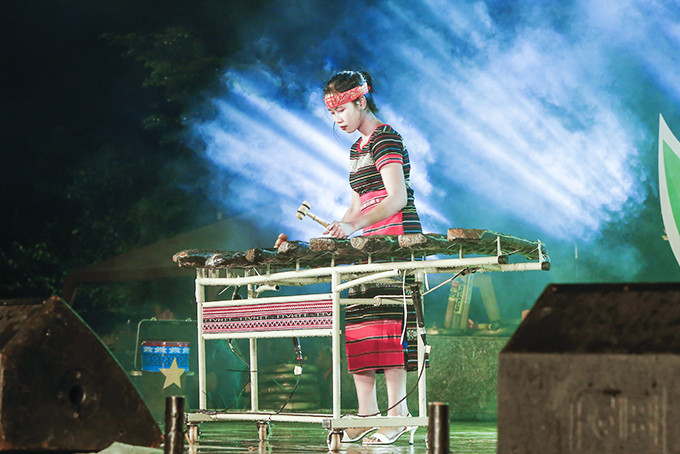
Khanh Hoa is known as the land of agar wood, swiftlets and festinating sea and island landscapes. Khanh Hoa residents are known to be generous and affectionate...
Khanh Hoa is known as the land of agar wood, swiftlets and festinating sea and island landscapes. Khanh Hoa residents are known to be generous and affectionate.
In this regard, Dai Nam Nhat Thong Chi Book, the largest official history record in the Feudalism, also says about the cultural values and beauty of the land and people of Khanh Hoa that locals are honest with pleasant customs; Those living in coastal areas live on fishing; Those living on the mountainside grow rice, plant mulberries, raise silkworms and do weaving; Most lead a simple life; They help each other in family celebration of weddings, funerals, etc.
 Raglai girl performs stone musical instrument. Raglai girl performs stone musical instrument.
|
In the Spring of 1653, the first Vietnamese generations came and integrated with the native people peacefully. Ethnic groups in Khanh Hoa Province help each other in life, building the homeland more and more prosperous and beautiful. Due to the characteristics of natural and human geography, Khanh Hoa fully converges the elements of mountain culture, plain culture and sea culture in the form of unique tangible and intangible culture. On the mountains, they include famous Khanh Son patau (stone instrument) found at the Doc Gao site, which was identified as "the largest prehistoric stone factory in Vietnam". This is also the land of the Akhàt ter (story-telling in prose) and the Akhàt jucar (story-telling with lyrics) commonly known as famous Raglai epics.
Through centuries of cohabitation, the Vietnamese people have exchanged and received the traditional cultural quintessence of ethnic groups to create the cultural identity of their own, enriching their lives and adding more treasures to national cultural heritage. Therefore, In terms of local culture, we notice the influence and interweaving of cultural nuances of the Vietnamese, the Cham, the Raglai and the Chinese, in which Vietnamese culture is the mainstream.
Due to the living conditions and environment, along with the dominant economic forms and traditional occupations, the Vietnamese in the Khanh Hoa Delta have communal house culture included in the Vietnamese village cultural tradition. The cultural system of communal houses, temples, shrines, etc., under the traditional cultural nuances of industrious and hardworking farmers, is featured through Am Chua Festival, Thap Ba Festival, communal house worshiping festivals, and occupation worshiping festivals over centuries honored in the strategy of preserving and promoting the national cultural identity.
In addition, residents living on fishing not only preserve marine cultural traditions with festivals worshiping communal houses - mausoleums, worshiping whales (Grandpa) and Ba Trao songs harmoniously combined in the worship of Ponagar - Thien Y A Na but also boasts a unique culture of swiftlets... All of the above factors have contributed to Khanh Hoa's unique cultural characteristics. Therefore, In terms of local culture, Khanh Hoa known as the land of Agar wood is a part of Vietnamese culture. That is the basic core of the "unity in diversity" of traditional Vietnamese culture.
Therefore, 370 years of construction and development of Khanh Hoa land is a process of persistent and arduous struggles with solidarity, creativity and bravery of ancestors’ generations. Those are the extremely valuable historical, cultural and humanistic traditions, in which the tradition of "When drinking water, think of its source", "When you eat a fruit, think of the man who planted the tree” have become noble morals of the nation, contributing to enriching and highlighting historical traditions and national cultural identities of the land of agar wood.
Entering the period of national industrialization and modernization, the Party Committee and people of Khanh Hoa are making efforts to accelerate socio-economic development; exploit all potentials and strengths; and enhance cooperation and development to attract domestic and foreign investment. In the context of regional and international integration, it is essential to strengthen cooperation and exchange with foreign countries while preserving and promoting the cultural identities and historical traditions of ethnic groups in Khanh Hoa Province. All is for the target of a nation of prosperity, justice, democracy and civilization.
T.L
Translated by N.T




